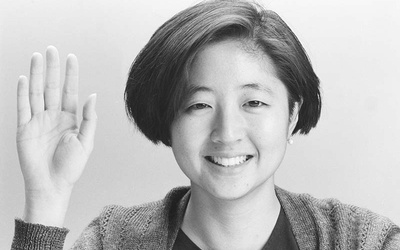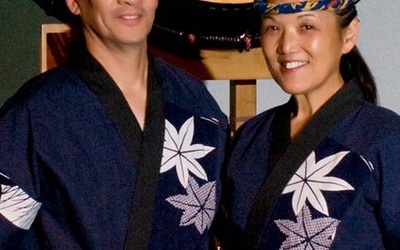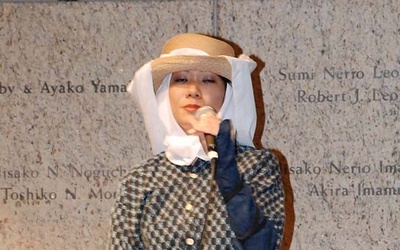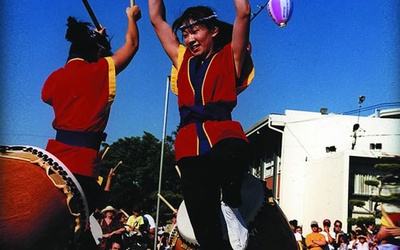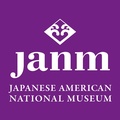
Sojin Kim
@skimSojin Kim é curadora e assistente especial do diretor do Smithsonian's Center for Folklife and Cultural Heritage. De 1998 a 2008, foi curadora do Museu Nacional Japonês Americano, onde continua ajudando como voluntária.
Atualizado em maio de 2011
Stories from This Author
In Memoriam: Karin Higa (1966–2013)
9 de Junho de 2014 • Sojin Kim
Karin Higa, JANM Senior Curator of Art from 1992 to 2006 and consultant on later projects, died October 29, 2013, following a battle with cancer. She was a native of Los Angeles who spent most of her career in Southern California, with a bachelor’s degree from Columbia University in New York and a master’s degree in art history from UCLA. At the time of her death, she was pursuing a Ph.D. in art history at USC. She was 47 years …
PJ & Roy Hirabayashi, 2011 National Heritage Fellows
29 de Setembro de 2011 • Sojin Kim
This September 2011, PJ and Roy Hirabayshi, who led San Jose Taiko for over 35 years, were formally recognized in Washington D.C. as National Heritage Fellows, an award presented annually by the National Endowment for the Arts and the most prestigious honor for artists working in folk and traditional arts. This is the second time that taiko artists have received this distinction, and it reflects how the form, in its diverse styles and philosophies, has become an intrinsic part of …
PAUL HOWARD TAKEMOTO and ALICE TAKEMOTO: On Resettlement, Revisiting the Past, and Reconnection - Part 2 of 2
28 de Maio de 2011 • Sojin Kim
Read part 1 >>REVISITING THE PASTIt took a visit to a cemetery in his father’s hometown in Hawaii—where he learned that his middle name commemorated a childhood friend who had been killed in combat during the war—and the dedication of the National Japanese American Memorial in D.C. in 2000 to pique Paul’s curiosity and begin his engagement with his family’s history. 700 minutes of oral history interviews later, his book Nisei Memories: My Parents Talk about the War Years was …
PAUL HOWARD TAKEMOTO and ALICE TAKEMOTO: On Resettlement, Revisiting the Past, and Reconnection - Part 1 of 2
22 de Maio de 2011 • Sojin Kim
Little Tokyo one of my favorite places feels like I’ve come home when my mom was young my grandfather took her thereto eat Chinese food we went back last year took a tour of the museum* she was so grateful I hope to return dreams of living in LA lots of musubi REFLECTION Paul Howard Takemoto recently composed this haiku. He is a seasoned writer—a published author with 16 years of journalism experience and a spokesperson for the Federal Aviation Administration. He sends these haiku …
“Hole Hole Bushi Girl”: Interview with Allison Arakawa
29 de Junho de 2010 • Sojin Kim
INTRODUCTIONOn February 27, 2010, the Japanese American National Museum opened its exhibition Textured Lives: Japanese Immigrant Clothing from the Plantations of Hawai’i, which featured the extraordinary research of Barbara Kawakami. As part of the opening celebration, the Museum invited singer Allison Arakawa to perform an example of Hole Hole Bushi, a Japanese American folk song form that developed directly from the plantation experiences of the Issei. Hole Hole Bushi is a hybrid term that combines the Japanese word for tune …
From Our Collection: Sumo and the “Threads” of Community
7 de Outubro de 2009 • Sojin Kim
On February 9, 1885, the first official Japanese migrants arrived in Hawai’i. Before an audience that included King David Kalakaua, they reportedly celebrated their arrival with a sumo match. Rooted in two thousand years of agrarian, Shinto tradition, sumo was transported to America by the Issei, who organized inter-island tournaments in Hawai’i as early as 1896, and major competitions between Hawai’i and mainland sumotori1 by the 1920s. Originally a harvest ritual, sumo was enjoyed as sport and entertainment among the …
From Obon to Kumi Daiko: Big Drum in Hawai`i
28 de Julho de 2007 • Sojin Kim
The steady beat of a taiko has long provided the accompaniment for Bon-odori celebrations in Hawai`i. The taiko tradition has been passed along from generation to generation and from one family member to another. Third-generation taiko player Kay (Watanabe) Fukumoto, who learned Obon taiko from her grandfather Tomio and her father, Albert Watanabe—former Keahua plantation musician—recalls: “Ever since I can remember, my mom would take me to my dad’s taiko practices during Obon season. My sister and I would just …

